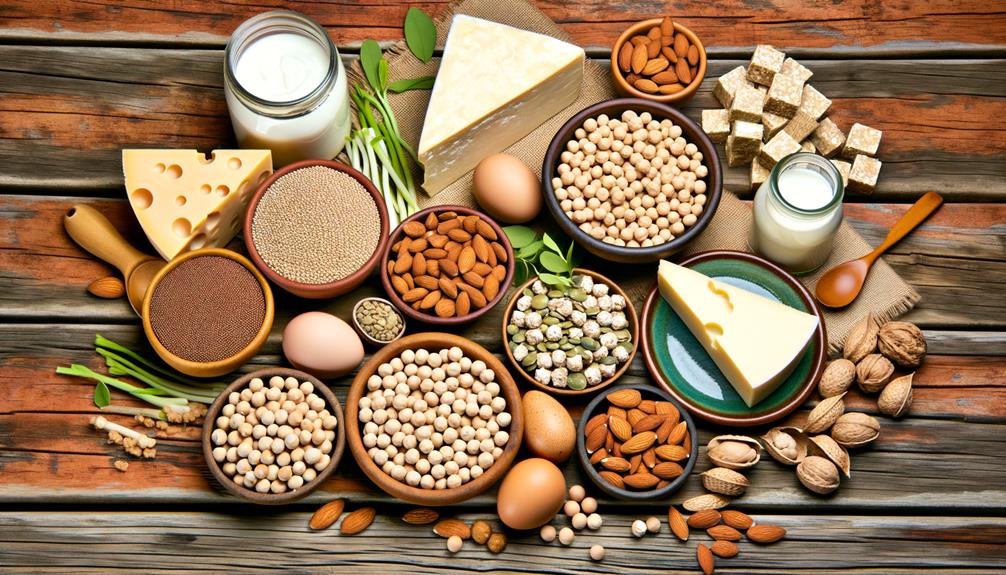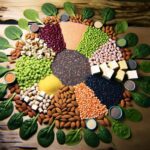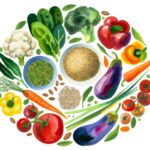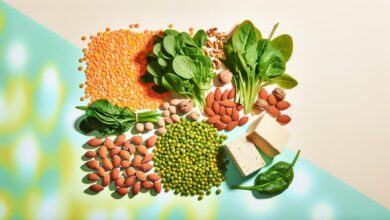In an age where the food pyramid is as archaic as the notion that protein only comes from meat, you’re among the enlightened few exploring the cornucopia of high-protein options for non-meat eaters. You’ve likely heard whispers of tofu transforming into delectable dishes that even staunch carnivores surreptitiously enjoy, or how legumes can be the unsung heroes of a muscle-building meal plan. Imagine a table laden with colorful, aromatic foods that are as rich in culture as they are in nutrients, a testament to the versatility of plant-based cuisine. Your culinary journey need not be bland or monotonous; it can be an exciting exploration of flavors that also cater to your protein needs. As you continue on this path, you’ll uncover that the answers to building a satisfying, protein-packed plate without meat are abundant, and the secrets to these satiating meals are just around the corner, waiting to be discovered.
Key Takeaways
- Plant-based protein sources offer a diverse range of flavors and nutrients, making them a great option for non-meat eaters.
- Tofu is a versatile and protein-packed foundation for many vegan dishes, and marination techniques can infuse it with delicious flavors.
- Legume-based dishes, such as chickpea salads and lentil soups, are not only nourishing but also inclusive for communal eating.
- Protein-rich vegan smoothies, with ingredients like nuts, seeds, and plant-based milks, provide nutrition and cultural insights into plant-based nutrition.
Understanding Vegan Protein Sources
You’ll be delighted to discover that the plant kingdom offers a rich tapestry of high-protein foods to fuel your vegan lifestyle with zest and vigor. In your quest to serve others with nourishing and compassionate choices, you’ll find that plant-based shakes and seitan stir fry stand out as powerhouses of protein.
Plant-based shakes are a whirlwind of nutrients, seamlessly blending peas, hemp, or brown rice proteins into your daily regimen. They’re an effortless way to start your day or replenish your body after serving your community. Imagine sipping on a creamy shake that not only satiates your hunger but also aligns with your values of kindness and sustainability.
Moving on to the savory side of things, seitan stir fry offers a cultural symphony of flavors. Seitan, made from wheat gluten, is a remarkable source of protein, often hailed as the ‘wheat meat’ of the vegan world. When tossed in a pan with a medley of colorful vegetables and spices, it transforms into a dish that’s not only protein-rich but also steeped in culinary tradition. It’s a meal that pays homage to the earth’s bounty, perfect for sharing with those you care for.
Tofu-Based Dishes for Protein
Often hailed as a culinary chameleon, tofu effortlessly absorbs the rich tapestry of flavors from spices and herbs, offering a versatile and protein-packed foundation for countless vegan dishes. As you explore tofu-based recipes, you’ll discover that the soybean curd benefits your health with its high protein content and essential amino acids. It’s a gift to your body and your taste buds, especially when you master tofu marination techniques that infuse it with delectable flavors.
- Tofu Marination Techniques
- Citrus and Soy: Marinate tofu in a mix of soy sauce, lemon juice, garlic, and ginger for a tangy kick.
- Spicy Peanut: Bathe tofu in a concoction of peanut butter, chili sauce, and lime for a Thai-inspired twist.
- Herb Infusion: Soak tofu in a medley of olive oil, basil, oregano, and rosemary, evoking the spirit of the Mediterranean.
Delight in the pleasure of serving these tofu-centric creations to those you cherish. Their palates will dance with the cultural infusion each dish offers, and you’ll feel the warmth of providing nutritious and compassionate meals. Remember, each slice of tofu is a blank canvas—paint it with the flavors of the world and watch as it becomes the star of your high-protein, plant-based feast.
Legume-Packed Meal Ideas
While mastering tofu marination expands your culinary repertoire, don’t overlook the humble legume, a powerhouse of protein that anchors a world of vibrant, plant-based dishes. You’ll find that legumes are not just a staple for individual nourishment but are also a cornerstone in the shared experience of communal eating.
Consider the versatility of chickpeas, for instance. They can transform into zesty chickpea salads brimming with a medley of herbs, crisp vegetables, and a tangy dressing. Such salads are not only a delight to your taste buds but also offer a substantial protein boost. They’re perfect for potlucks and family gatherings, where you can serve a dish that’s both nourishing and inclusive.
And let’s not forget the comforting warmth of lentil soups. These can be a canvas for cultural expression, simmering with flavors from around the world. Imagine a Moroccan-inspired lentil soup, infused with cumin, cinnamon, and turmeric, or an Italian rendition with tomatoes, basil, and a drizzle of olive oil. These soups serve as a testament to the adaptability of legumes, capable of carrying diverse flavors that bring people together over a shared love for wholesome, plant-based food.
Protein-Rich Vegan Smoothies
Dive into the creamy realm of protein-rich vegan smoothies, where nuts, seeds, and plant-based milks blend into a symphony of nourishing delight. As you seek to serve others with hearty, healthful options, these smoothies offer a cultural insight into the flavorful world of plant-based nutrition. They aren’t just delicious; they’re also packed with essential nutrients that support well-being.
- Key Ingredients for Boosting Protein
- Nuts and Nut Butters: Almonds, cashews, and peanut butter provide a rich, smooth texture and a punch of protein.
- Seeds: Incorporate seed cycling by adding flaxseeds, chia seeds, or hemp hearts for a protein boost that also offers omega-3 fatty acids.
- Plant-Based Milks: Soy, almond, or oat milk can serve as the liquid base, each bringing its own unique profile of proteins and flavors.
- Enhancements for Nutrition and Taste
- Nutritional Yeast: With its cheesy flavor, it’s a perfect addition to a savory smoothie while enriching it with protein and B-vitamins.
- Greens: Spinach or kale can sneak in extra nutrients without overpowering the taste.
- Fruits: Berries, bananas, or mango can add natural sweetness and antioxidants.
Quinoa as a Protein Powerhouse
Discover the robust flavors and exceptional protein content that quinoa, an ancient grain revered by the Incas, brings to vegetarian tables worldwide. This nutrient-dense seed offers a culinary canvas rich in heritage and health. Quinoa versatility shines through in its ability to be a main dish, a side, or even a delightful addition to salads, soups, and stews.
When you’re aiming to nourish and serve others with plant-based goodness, quinoa stands out as a protein powerhouse. Compared to other grains, its protein profile is complete, boasting all nine essential amino acids. Here’s a glance at protein comparisons to help you appreciate quinoa’s place on your table:
| Food Item | Protein Content (per 100g) |
|---|---|
| Quinoa | 14g |
| Brown Rice | 2.6g |
| Whole Wheat Pasta | 5g |
| Lentils | 9g |
| Chickpeas | 19g |
This table highlights quinoa’s respectable position among plant-based protein sources, although chickpeas take the lead. Still, the versatility and flavor profile of quinoa might make it a more suitable choice for your culinary creations. Integrating quinoa into your meals is an homage to ancient traditions, a nod to cultural insights, and a celebration of flavors that serve and satisfy.
Frequently Asked Questions
How Can I Ensure I’m Getting a Complete Protein Profile From Plant-Based Meals Without Using Soy Products?
Variety’s the spice of life—combine legumes with protein-rich grains for a complete profile. Think quinoa with black beans or lentils with barley. Serve these flavorful pairings to nourish and delight others.
What Are Some Quick and Simple High-Protein Vegan Snacks I Can Prepare When I Don’t Have Time to Cook a Meal?
You’ll love munching on protein bars and edamame snacks—quick, flavorful bites that pack a protein punch and serve your body’s needs without any fuss. Perfect for your compassionate, on-the-go lifestyle!
Are There Any Specific Vitamins or Minerals I Should Pay Attention to When Following a High-Protein, Non-Meat Diet?
As you navigate the garden of your diet, focus on micronutrients; calcium consideration is key. Embrace colorful, plant-based dishes that serve both your body’s needs and your desire to nourish others.
How Can I Incorporate High-Protein Seeds, Like Hemp or Chia, Into My Diet Without Resorting to Smoothies or Typical Breakfast Foods?
You can sprinkle hemp or chia seeds onto salads with protein-rich dressings, or use them to create flavorful seed crusts for your casseroles. It’s a delicious way to serve up essential nutrients.
Can You Suggest Ways to Increase the Protein Content in Vegan Desserts Without Compromising on Taste and Texture?
You’ll be the hit of the party by boosting your vegan desserts with protein powders and nut butters, creating indulgent treats that are both flavorful and nourishing for your community gatherings.







